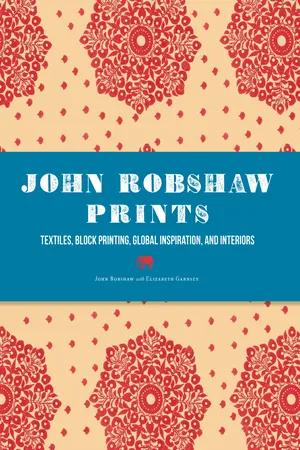![]()
Block carvers in Sanganer.
Note how delicately the printer lines up the block before he stamps.
If they could, every one of my textiles would pipe up with a story. And not just a single story, but an interwoven narrative about a particular trip to a distant country, and the people I meet there, the ideas they inspire, and the techniques they are generous enough to teach me. Wherever I travel, whether to India or Thailand, Indonesia or Nepal, I draw from the visual art and music and languages I hear, as much as from the overgrown exotic gardens and ancient temples I see, and the religious festivals and the Bollywood mayhem of the street life I negotiate, to make new prints. But it is the traditional printing methods I’ve learned along the way that have unleashed countless new ideas. They are what have opened up unexpected new directions for me as I have grown as an artist and designer; I’ve just stumbled in, the way local taxicabs careen left or right—or seemingly both at the same time—but you can’t predict the direction, so you just have to jump into the void.
My travels have introduced me to dozens of indigenous printing techniques, but a few have become central to my collections over the years. Block printing became my teacher and my muse, and my temperamental mistress. I was drawn to it the first time I saw it done in India, and I fell in love with it—and with India, too. If my personality were an art form, I would be block printing. The rhythm and method allow for all kinds of free-form ideas and random action. Any missteps or confusion can become instead an innovation, a new style. The beauty of block printing’s exactitude is equal to the fun of its malleability. Many of the photos in this chapter provide a glimpse into the expertise of the printers and artisans with whom I work in India, along with a step-by-step illustration of how block printing gets done.
I am indebted to all of my friends in India whom I have had the pleasure (and pain, at times) to work with over the years and to learn from and grow with. To say the least, it has not always been easy—though I have enjoyed our tussles, brawls, and near misses. On the other hand, I have been on the receiving end of their amazing hospitality, their insights, and their support as partners and friends.
A few other techniques I incorporate into my collections but don’t rely on, because of technical challenges, are the batiking I learned in Yogyakarta, Indonesia; mud printing with natural indigo, which I attempted in Bagru, India; and ikat weaving in Isaan, Thailand, where I merely watched, mesmerized, as the looms swayed back and forth. But elements of all of these, along with block printing, are what come together to form my hybrid, eccentric designs that are at once ancient and modern, time-honored and original—for better or for worse!
Block Printing
Some scholars believe block printing originated in India as early as 3000 B.C.E., but no actual textiles or blocks that old have survived. Printed textiles were used in parts of the Caucasus Mountains around 2000 B.C.E. And Herodotus (450 B.C.E.) makes reference in his histories to peoples from the same region who painted animal figures on their clothing, while Strabo, who lived from 63 B.C.E. to 20 C.E. in what is now Turkey, documents Indian printed textiles. And in the first century C.E., Pliny the Elder alludes to the painting and dyeing of textiles. Archeologists in Egypt uncovered the earliest known block-printed fabric, a fourth-century child’s tunic in white linen, stamped with blue star-shaped designs in a diamond pattern.
A quilt in progress being stamped with my “Hedge” print, Spring 2010.
Chipping away at a block for my “Darter” print.
But many scholars believe it was in India where the practice of printing fabrics was perfected, as early as the twelfth century, and it was Indian craftsmen who elevated it to the world-renowned art form it became by about the seventeenth century. That was when families of artisans called chhipas (literally, people who stamp or print) settled in the town of Bagru, about thirty-five kilometers east of Jaipur. There, by the river Sanjaria, generation after generation perfected and perpetuated the art of block printing; in many cases, to this day, Bagru printers have managed to preserve the use of natural dyes in spit...






